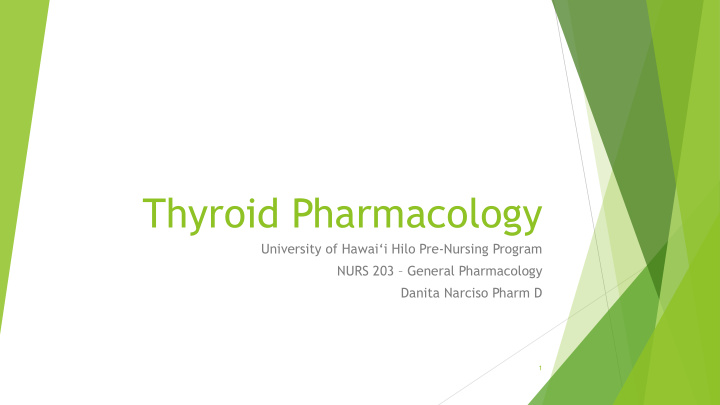



Thyroid Pharmacology University of Hawai‘i Hilo Pre -Nursing Program NURS 203 – General Pharmacology Danita Narciso Pharm D 1
Learning Objectives: Understand what factors control the release of thyroid hormone Know what thyroid hormone does, as well as what to expect in excess or deficient levels of thyroid hormone Understand the role of iodine in thyroid hormone Know the basics of thyroid medications 2
Thyroid Hormone The thyroid gland is part of the endocrine system A hormone is a signaling molecule secreted from a gland Thyroid hormone is secreted from the thyroid gland A hormone’s target is usually far from its site (gland) of secretion Hormones must be transported to their targets by the blood in the circulatory system 3
Thyroid Hormone – In the body Hormones involved TRH Thyrotropin releasing hormone: Synthesized by the hypothalamus and stimulates the release of TSH TSH Thyroid stimulating hormone: Synthesized by the anterior pituitary and stimulates the release of TH TH Thyroid hormone T3 & T4 SST Somatostatin: Inhibitory hormone released by the hypothalamus 4
What does thyroid hormone do? Regulates growth Cerebral development, mental dulling, or hyperexcitability Regulates metabolic rate Increase cholesterol synthesis & cholesterol excretion into the bile Effect protein mass Increase GI motility and secretion of gastric fluids Helps maintain water and electrolyte balance Increase or decrease need for oxygen in the periphery leading to an increase or decrease in cardiac output Hyperactive muscle reactions – muscle sluggishness Helps regulate temperature Helps maintain the reproduction cycle and contents of breast milk 5
Hypothyroidism – Normal- Hyperthyroidism TRH SST TRH SST TRH SST Hypothalamus - - - + + TSH TSH Pituitary TSH + + - + + - Thyroid T3 & T4 T3 & T4 T3 & T4 CIRCULATION CIRCULATION CIRCULATION 6
Thyroid hormone Liver: Type 1 deiodinase 7
Drugs & Thyroid Hormone Drugs that effect thyroid hormone levels: Enzyme inducers: Rifampin, carbamazepine, and phenobarbital Decrease thyroid hormone levels Drugs that contain iodine Amiodarone – can cause hyperthyroidism How thyroid hormones effect drugs Hyperthyroidism Increases: warfarin Decreases: digoxin, benzodiazepines, & opiates Hypothyroidism Decreases: warfarin Increases: digoxin, benzodiazepines, & opiates 8
Hypothyroidism Primary (thyroid), secondary (pituitary), tertiary (hypothalamus) 1 – Low T3 & T4, high TSH, 2 & 3 (Low T3, T4, & TSH) Goiter Iodine deficiency Children Cretinism: Dwarfism and mental retardation – reversible with adequate amounts of thyroid hormone given early enough in life Adults – severe Myxedema: Coma, hypotension, hypoventilation, hypothermia, bradycardia, hyponatremia, and hypoglycemia Classic presentation Dry skin, cold intolerance, lethargy, depression, and weight gain 9
Hypothyroidism Medications Levothyroxine (T4) – synthetic thyroid hormone Dosing: Based on drug response, brand may be medically necessary, measured in mcg IM, PO, IV Kinetics: Bioavailability 40-80%, half life varies euthyroid (7 days), hypothyroid (10 days), hyperthyroid (3 days) Adverse effects Hyperthyroidism: Elevated temperature, diarrhea, hand tremors, increased irritability, CNS, tachycardia, sweating, vomiting, weight loss Monitor thyroid panel 10
Hypothyroidism Medications Liothyronine (T3) – synthetic thyroid hormone Dosing: Based on drug response, brand may be medically necessary, measured in mcg PO, IV Kinetics: Incomplete intestinal absorption, 24 hour half life Adverse effects More active form. Can be toxic monitoring important. Hyperthyroidism: Elevated temperature, diarrhea, hand tremors, increased irritability, CNS, tachycardia, sweating, vomiting, weight loss Monitoring: Thyroid panel - efficacy 11
Hypothyroidism Medications Desiccated Thyroid Liotrix Ground thyroid gland Mixture of T3 & T4 Can cause allergic reaction Normal circulation levels Expensive Not necessary, T4 gets converted to T3 any way 12
Hyperthyroidism Primary (thyroid), secondary (pituitary), tertiary (hypothalamus) 1 – High T3 & T4, low TSH / 2 & 3 (high T3, T4, & TSH) Thyrotoxicosis Excess thyroid hormone circulating – toxic types of goiter or cancers that produce and excrete thyroid hormone Too much thyroid hormone – increased metabolic rate, temperature, and pulse, restlessness, anxiety, emotional instability Thyroid storm – sudden onset of hyperthyroid symptoms with emphasis on cardiovascular and CNS symptoms Causes serious cardiovascular disease – afib, heart failure, osteoporosis, liver failure, neurologic irritability 13
Hyperthyroidism Medications Propylthiouracil (PTU) – Thioamide derivative MOA: Does not effect exogenous thyroid hormone, inhibits the synthesis of thyroid hormone by inhibiting iodide incorporation into tyrosine and the coupling of iodotyrosines * inhibits the conversion of T4 to T3 Uses: Hyperthyroidism, prior to radiotherapy surgery, or an adjunct to thyroid storm Kinetics: PTU has a half life of only 1-2 hours but its peak effect is not seen until 17 weeks, metabolized in the liver and excreted by the kidneys Dosing: Based on age – children between 6 & 10 years is 50-150 mg daily, children over 10 years 50-300 mg, and adults 300-900 mg daily in divided doses Adverse effects: Loss of taste, nausea, vomiting, dizziness, skin rash, fever, signs of infection secondary to leukopenia or agranulocytosis Can cross the placenta 14
Hyperthyroidism Medications Methimazole – Thioamide derivative MOA: Does not effect exogenous thyroid hormone, inhibits the synthesis of thyroid hormone by inhibiting iodide incorporation into tyrosine and the coupling of iodotyrosines Uses: Treatment of hyperthyroidism before surgery and hyperthyroidism Kinetics: Half life 5-6 hours – peak 7 weeks, metabolized in the liver and excreted by the kidneys Dosing: Adult (maintenance) 5-30 mg in 1-2 divided doses, pediatric maintenance dose should not exceed 30 mg/day – but is generally bases on weight 0.2 mg/kg/day ADRs: Similar to PTU Loss of taste, nausea, vomiting, dizziness, skin rash, fever, signs of infection secondary to leukopenia or agranulocytosis Can cross the placenta 15
Iodine Potassium iodide Uses: Reduce the vascularity of thyroid prior to removal, goiter, complete with radioactive thyroid for uptake ADRs: “ Iodism ” - rash, goiter, flulike symptoms, swelling of salivary glands, mucus membrane ulceration, confusion/depression, nausea and diarrhea Sodium I131 (radio active iodide) Uses: Thyroid storm/thyroid cancer ADRs: Swelling, rash leukocyte infiltration, Interactions: Antithyroid agents and amiodarone – inhibit the effect of I131 16
QUESTIONS 17
Recommend
More recommend